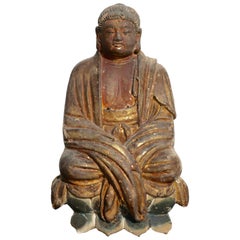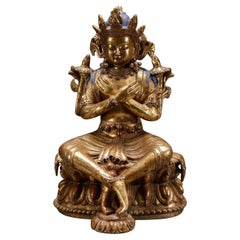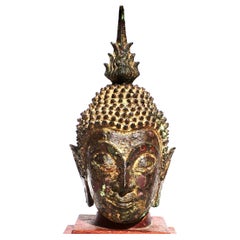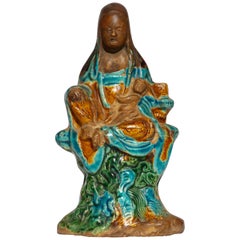Want more images or videos?
Request additional images or videos from the seller
1 of 10
19th Century 40" Chinese Polychromed Statue or Guanyin or Buddha
Price:$900
About the Item
- Dimensions:Height: 40 in (101.6 cm)Diameter: 11.5 in (29.21 cm)
- Style:Chinese Export (Of the Period)
- Materials and Techniques:Wood,Polychromed
- Place of Origin:
- Period:
- Date of Manufacture:circa 1780
- Condition:Wear consistent with age and use.
- Seller Location:Dallas, TX
- Reference Number:1stDibs: LU177426190453
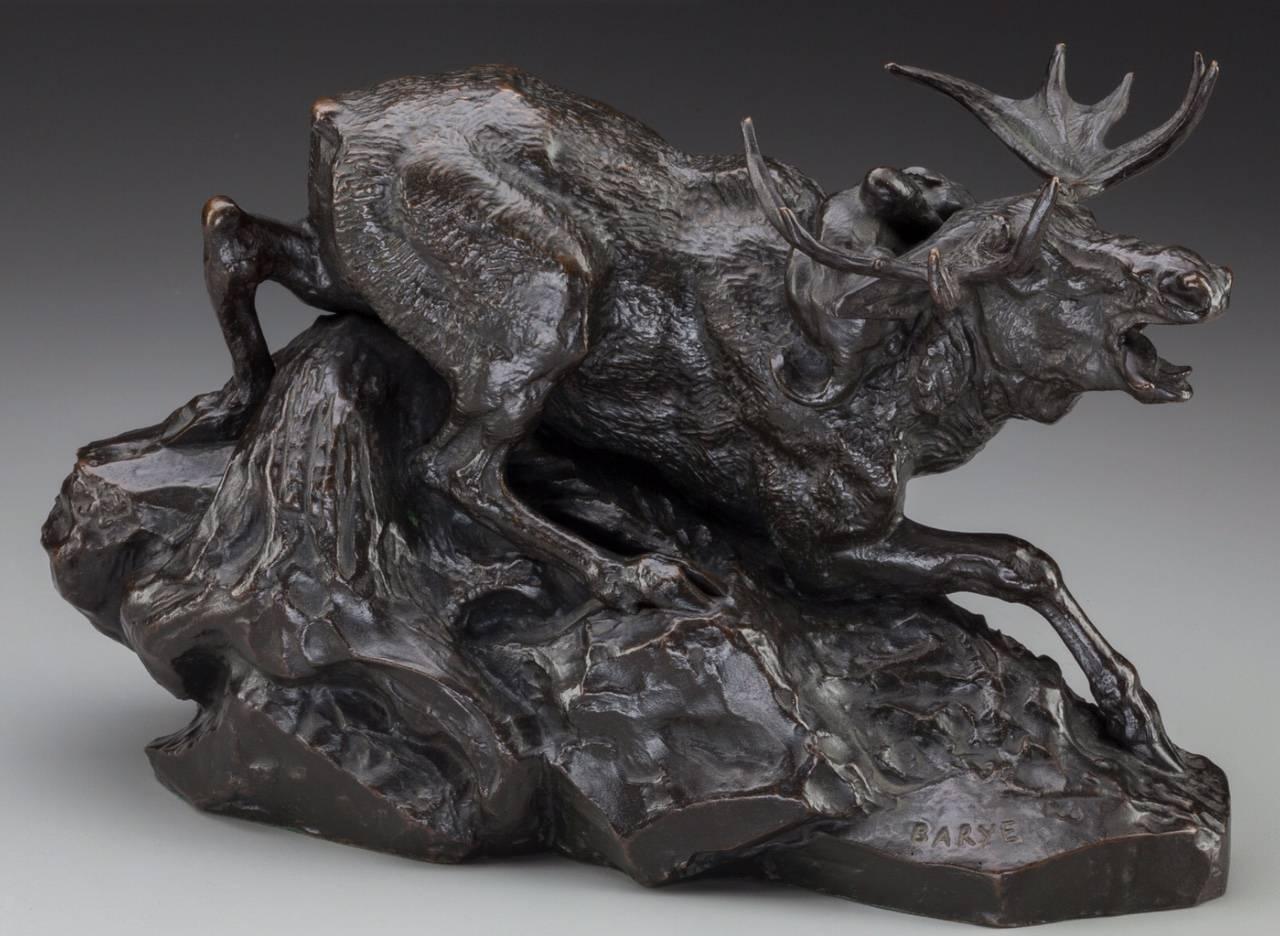
About the Seller
4.9
Gold Seller
Premium sellers maintaining a 4.3+ rating and 24-hour response times
Established in 2000
1stDibs seller since 2015
448 sales on 1stDibs
Typical response time: 2 hours
Authenticity Guarantee
In the unlikely event there’s an issue with an item’s authenticity, contact us within 1 year for a full refund. DetailsMoney-Back Guarantee
If your item is not as described, is damaged in transit, or does not arrive, contact us within 7 days for a full refund. Details24-Hour Cancellation
You have a 24-hour grace period in which to reconsider your purchase, with no questions asked.Vetted Professional Sellers
Our world-class sellers must adhere to strict standards for service and quality, maintaining the integrity of our listings.Price-Match Guarantee
If you find that a seller listed the same item for a lower price elsewhere, we’ll match it.Trusted Global Delivery
Our best-in-class carrier network provides specialized shipping options worldwide, including custom delivery.You May Also Like
Buddha Statue 19th Century Alabaster
Located in New York, NY
18th/19th century Buddha Statue carved of Alabaster. Burmese Shan Buddha Statue 1800ca, collected in Myanmar Shan State 1998. Legs crossed, the left hand in the lap, and the right ha...
Category
Antique Early 1800s Burmese Figurative Sculptures
Materials
Alabaster
Gold Ornaments of Antique Chinese Buddha Statues / 17th-19th Centuries
Located in Sammu-shi, Chiba
This is thought to be part of the decoration of a gilt-bronze Buddha made in ancient China, from the late Ming to the Qing dynasties.
It is thought that it is probably an ornament t...
Category
Antique 17th Century Chinese Ming Figurative Sculptures
Materials
Copper
$500
H 4.22 in W 3.98 in D 2.49 in
19th Century Giltwood Polychrome Statue of Madonna
Located in Dallas, TX
19th century giltwood polychrome statue of Madonna is a superbly artistic rendition of the Mother of Jesus, uncharacteristically holding our both han...
Category
Antique 1850s French Figurative Sculptures
Materials
Giltwood
Japanese antique small stone Buddha statue / Seated Buddha / 19th century / Edo
Located in Sammu-shi, Chiba
This is a small stone Buddha statue, a "seated Tathagata," created around the 19th century, during the late Edo period in Japan. Stone Buddha statues are scattered throughout Japan, ...
Category
Antique 19th Century Japanese Edo Figurative Sculptures
Materials
Stone
$600
H 10.56 in W 7.88 in D 4.14 in
Larger Than Life Terracotta Buddha Bust of Guanyin, Early 20th Century, China
Located in Antwerp, BE
Monumental Terracotta Bust of Guanyin — China, Early 20th Century
A striking, larger-than-life terracotta bust of Guanyin, the bodhisattva of compassion, originating from China and ...
Category
Early 20th Century Chinese Chinese Export Busts
Materials
Terracotta
$5,776
H 30.71 in W 22.84 in D 14.57 in
Guanyin Buddha
Located in Munich, DE
Rare vintage Buddha, the Bodhisattva of compassion and mercy.
Category
Vintage 1920s Figurative Sculptures
Materials
Wood
Massive Chinese Guanyin Statue in Jade-Like Green Hardstone
Located in Ottawa, Ontario
Massive 37 1/2"- inch high Chinese Guanyin statue in Green Jade-like hardstone
Late 20th century,
The reclining deity adorned with a crown emulating ...
Category
20th Century Chinese Chinese Export Figurative Sculptures
Materials
Other
Antique Late 19th Century Gilded Thai Buddha Bronze Statue
Located in Torino, IT
Antique late 19th century Thai Buddha bronze statue, with a lacquered and gilded surface, heavy and with beautiful details.
Category
Antique Late 19th Century Thai Sculptures
18-19th Century Bronze Naga Meditating Bronze Buddha Statue
Located in Kastrup, DK
Bronze Buddha depicted in meditation pose sheltered by a Naga (a seven-headed snake). I two parts.
Naga's body coiled up to serve as a cushion for the Buddha with 7 pronged head prov...
Category
Antique Mid-18th Century Burmese Other Figurative Sculptures
Materials
Bronze
Antique Chinese Painted Clay Buddha Statue
Located in Queens, NY
"Antique Chinese (early 20th Century, Republic of China) clay Buddha sculpture with painted details in red, green, and blue. (Similar sculptures: NWL2497, ...
Category
20th Century Chinese Chinese Export Figurative Sculptures
Materials
Clay
More From This Seller
View AllEarly Ming Dynasty Chinese Buddha Statue, circa 14th Century
Located in Dallas, TX
A very fine late Yuan to early Ming Chinese terracotta gilt and polychrome painted Buddha figure, he is dressed in thick robes, his hair arranged in ty...
Category
Antique 15th Century and Earlier Chinese Ming Figurative Sculptures
Materials
Terracotta
18th C. Tibetan Gilt Bronze Green Tara Buddha Statue
Located in Dallas, TX
A Gilt Bronze Tibetan Representation Of A rare Green Tara Buddha Statue. Sounds like there is an item sealed inside.
Gilt Bronze and Copper.
Early 1...
Category
Antique 1790s Tibetan Tibetan Figurative Sculptures
Materials
Bronze
Ayutthaya Lacquered And Gilt Bronze Buddha Head 15th Century
Located in Dallas, TX
Ayutthaya Lacquered and Gilt Copper Bronze Buddha Head
Circa 15th Century
A beautifully lacquered and gilt bronze Buddha head from the Kingdom of Ayutthaya, Thailand, circa 15th ...
Category
Antique 15th Century and Earlier Thai Ming Figurative Sculptures
Materials
Bronze
Ming Dynasty Songzi Guanyin with Child
Located in Dallas, TX
A Chinese Fahua glazed pottery figure of Songzi Guanyin with child. A rare yellow, turquoise and green glazed statue of Guanyin with downward gaze h...
Category
Antique 16th Century Chinese Ming Figurative Sculptures
Materials
Pottery
Large 19th Century Parker American Carousel Horse
By Parker
Located in Dallas, TX
Carousel Horse (American, 19th C) Wood carved with traces of paint with stand.
An amazing decorative statement; this charming wood carved carousel horse shows character with traces of its original paint and jointed construction. The glass eye balls and facial features is a focal point from tail to hoof. Probably coming originally from a Long Island New York fair carousel ride, this bold yet soft piece draws eyes and complimentary statements as soon as guests see it. Comes with decorative wood stand!
Attributed to Parker carousel horses...
Category
Antique 1890s American American Classical Animal Sculptures
Materials
Wood
Han Dynasty Polychromed Horse and Rider
Located in Dallas, TX
A fine Han dynasty polychrome painted terracotta horse and rider. The warrior is dressed in orange and black on a black horse.
Measures: Height 14 inches (35 cm)
Width 12.5 inches (32 cm).
Condition: Excellent with tastefully undetectable repairs.
During the unification of China under the Han dynasty, bands of mounted nomadic warriors from the north threatened the country. In order to thwart their attacks, the Chinese sought to import stronger, faster steeds from Central Asia (as opposed to the Mongol ponies used by the invaders), eventually leading to the creation of the Silk Road. This small sculpture of a mounted soldier reveals the crucial military role of the horse. When compared to the diminutive stature of the rider, the importance of the horse becomes readily apparent. This creature provided security and strength, allowing the empire to secure its borders and expand its influences across Central Asia. The magnificent regalia of the horse, including a brilliantly painted saddle in red and green/gold, reflect the respect this animal received. The warrior as well is gorgeously decorated with a painted red tunic and gray chest...
Category
Antique 15th Century and Earlier Chinese Han Figurative Sculptures
Materials
Terracotta
